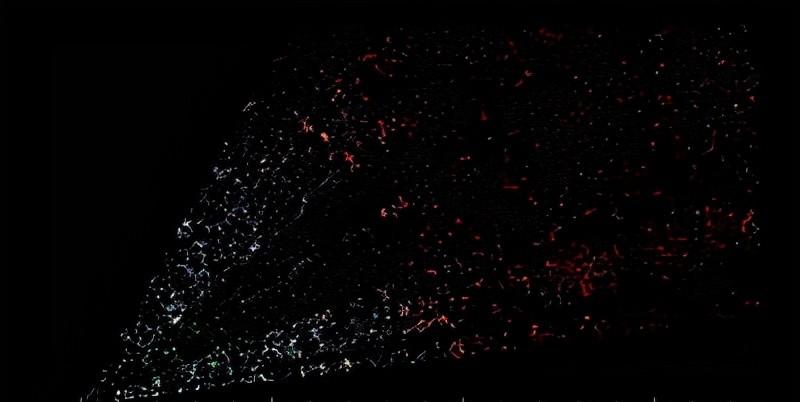To understand the past and future of the universe, we need a complete three-dimensional map. The U.S. Dark Energy Spectrometer (DESI) project broke the record for all previous surveys of 3D galaxies, creating the largest and most detailed map of the universe ever created after completing the first seven months of surveys. This extremely detailed 3D map will help to better understand dark energy and the past and future of the universe. The techniques and achievements used in the investigation will also help scientists uncover the secrets of the universe's most powerful light source.

DESI's 3D "CT scan" of the universe. The Earth is in the lower left corner, and each colored dot represents a galaxy, which in turn consists of 100 billion to 1 trillion stars.
Dark energy: Dark energy is an energy that drives the movement of the universe. Neither it nor dark matter absorbs, reflects, or radiates light, so humans cannot directly use existing technology to make observations. Human studies of the universe have shown that 26.8% of the universe is always composed of dark matter, and dark matter is like glue that connects all matter together. A new study has found that some dark matter is disappearing, and the reason for its disappearance is dark energy. Dark energy is likely to be consuming dark matter, and if this inference is correct, this phenomenon will have a significant impact on the future of the universe.
In the distribution of galaxies in 3D maps, there are huge clusters, filaments, and gaps. They are the largest structures in the universe. But in it, you'll find imprints of the early universe, and its history of expansion since then.
Completing the survey task requires collecting detailed chromatographic images of millions of galaxies covering more than a third of the entire sky. By breaking down the light from each galaxy into its spectrum, DESI determines how much the light has redshifted, and it is these redshifts that allow DESI to see the depth of the sky.
In general, the more redshift a galaxy's spectrum, the farther it is. With the help of a 3D map of the universe, physicists can chart galaxy clusters and superclusters. These structures carry the echoes of their initial formation, when they were just ripples in the baby universe. By combing through these echoes, physicists can use DESI data to determine the expansion history of the universe. The history of inflation is inextricably linked to the fate of the entire universe.
The University of Arizona is using DESI data to understand the behavior of intermediate-mass black holes in small galaxies. In large galaxies, the active galactic nucleus is one of the brightest objects in the known universe. But in smaller galaxies, active galactic nuclei may be weaker and more difficult to distinguish from newborn stars. The spectra taken by DESI could help solve this problem, and its wide coverage in the sky will produce more information about the cores of small galaxies than ever before. In turn, these cores will provide scientists with clues about how brightly active galactic nuclei formed in the early universe.
Durham University in the United Kingdom uses DESI data to understand the evolution of the quasar itself. It is thought that quasars begin with a layer of dust that makes the light they emit turn red, like the sun passing through the haze. As they age, they disperse this dust and become bluer. But the lack of data on red quasars makes it difficult to test this theory. DESI is changing that, finding more quasars than any previous survey, with an estimated 2.4 million quasars in the final survey data.
Currently, the DESI project has cataloged more than 7.5 million galaxies and is increasing at a rate of more than 1 million per month. In November 2021 alone, DESI cataloged redshifts from 2.5 million galaxies. By the end of its operation in 2026, DESI's catalog is expected to have more than 35 million galaxies, enabling a wide variety of cosmological and astrophysical studies.
The Dark Energy Spectroscopic Instrument (DESI) is a project led by lawrence Berkeley National Laboratory (LBNL) to create a larger 3D map of the universe to uncover the chemical composition, distance, and speed of movement of celestial bodies to better understand the mysterious dark energy that accelerates the expansion of the universe.
DESI began construction in 2015 and installed the Mayall telescope at the Kitt Peak National Observatory, debuting at the end of 2019, but coincided with the arrival of the new coronavirus that caused the telescope to shut down for several months; in December 2020, DESI opened its eyes again and looked to the sky to begin testing hardware and software; and in May 2021, it officially launched a scientific investigation. Just seven months later, scientists have announced that DESI has produced the largest and most detailed 3D map of the universe ever made, collecting more than 7.5 million lights from galaxies, and expecting to add 27.5 million galaxies by the end of operation in 2026, far exceeding the 930,000 galaxies previously surveyed by Sloan Digital Sky Survey.